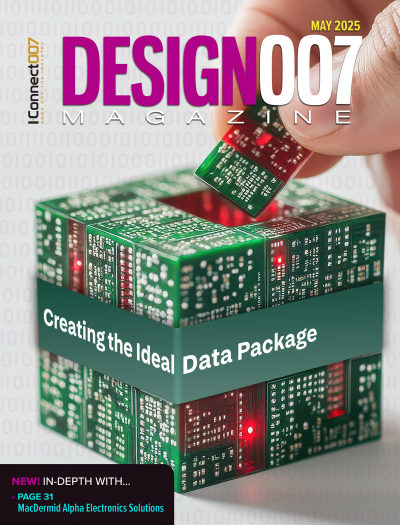-

- News
- Books
Featured Books
- design007 Magazine
Latest Issues
Current Issue
All About That Route
Most designers favor manual routing, but today's interactive autorouters may be changing designers' minds by allowing users more direct control. In this issue, our expert contributors discuss a variety of manual and autorouting strategies.

Creating the Ideal Data Package
Why is it so difficult to create the ideal data package? Many of these simple errors can be alleviated by paying attention to detail—and knowing what issues to look out for. So, this month, our experts weigh in on the best practices for creating the ideal design data package for your design.

Designing Through the Noise
Our experts discuss the constantly evolving world of RF design, including the many tradeoffs, material considerations, and design tips and techniques that designers and design engineers need to know to succeed in this high-frequency realm.
- Articles
- Columns
- Links
- Media kit
||| MENU - design007 Magazine
Design Challenges: From The Assembler’s Viewpoint
June 29, 2023 | Andy Shaughnessy, I-Connect007Estimated reading time: 2 minutes
Fabricators are fairly vocal about the design issues that they encounter, especially with brand-new customers. They are, after all, the next step in the process. But we don’t hear as much about design issues from EMS providers.
This month, we asked experts from the PCB assembly segment to share their thoughts about design challenges that affect technologists on the EMS side. They offer a look at the world of PCB design from downstream in the process, and they raise several interesting points.
Have your assembly partners offered you any advice on design for assembly (DFA) techniques?
Michael Ford
Aegis Software
Q. What is your main concern for PCB designers?
Design for sustainability (DFS), including the right to repair, product and material reuse, and effective recycling, as well as the CO2 and energy impacts of materials and products are the sustainability credentials that customers across the industry are building into their requirements. The industry has a choice—to be driven by carrots from customers in a way that is good for them and the industry, or wait for the inevitable sticks from governments, which typically introduce a sudden burden without a focus on complementary benefits.
Designers need to take extreme care now when defining and measuring their designs against these emerging requirements. They must understand how to benefit from these requirements and be able to communicate information in a way that ensures the privacy of IP. Emerging technologies address these concerns, but to save investment and expense, they should be adopted in a way that creates interoperability throughout the industry.
Unlike manufacturing, where a single partner is responsible for producing many of the same product line together, the recycling of products happens at random as individual products reach end of life. Information for sustainability must therefore be available more widely, smartly, and more securely. A holistic discussion is needed.
Q. What issue should PCB designers be more aware of?
Designers continuously learn how to improve their designs. A significant contribution to this process is information related to manufacturing, actual materials used, and the way that the product is used in the market. The issue here is that context is very important. Results of customer feedback, warranty claims, and reliability of the product in the market are affected by several variables which design does not currently have visibility of nor control over.
The same product may be manufactured at several different locations, with different configurations and settings, all of which alter the manufacturing performance. The choice of materials often deviates from expectations, as material shortages or increased costs trigger the use of local or more cost-effective materials. These may perform differently in certain conditions. Customers may use, and abuse, products in certain applications. How can all these factors be measured? Understanding the results of product design decisions means that detailed context of manufacturing, materials, and use-case information is essential if we are to create better designs that reduce the cost of manufacturing, poor quality, and exceptions occurring in the market. The use of solutions around an interoperable digital twin architecture standard, such as IPC-2551, may be the way forward.
To read this entire article, which appeared in the June 2023 issue of Design007 Magazine, click here.
Suggested Items
Intervala Hosts Employee Car and Motorcycle Show, Benefit Nonprofits
08/27/2024 | IntervalaIntervala hosted an employee car and motorcycle show, aptly named the Vala-Cruise and it was a roaring success! Employees had the chance to show off their prized wheels, and it was incredible to see the variety and passion on display.
KIC Honored with IPC Recognition for 25 Years of Membership and Contributions to Electronics Manufacturing Industry
06/24/2024 | KICKIC, a renowned pioneer in thermal process and temperature measurement solutions for electronics manufacturing, is proud to announce that it has been recognized by IPC for 25 years of membership and significant contributions to electronics manufacturing.
Boeing Starliner Spacecraft Completes Successful Crewed Docking with International Space Station
06/07/2024 | BoeingNASA astronauts Barry "Butch" Wilmore and Sunita "Suni" Williams successfully docked Boeing's Starliner spacecraft to the International Space Station (ISS), about 26 hours after launching from Cape Canaveral Space Force Station.
KIC’s Miles Moreau to Present Profiling Basics and Best Practices at SMTA Wisconsin Chapter PCBA Profile Workshop
01/25/2024 | KICKIC, a renowned pioneer in thermal process and temperature measurement solutions for electronics manufacturing, announces that Miles Moreau, General Manager, will be a featured speaker at the SMTA Wisconsin Chapter In-Person PCBA Profile Workshop.
The Drive Toward UHDI and Substrates
09/20/2023 | I-Connect007 Editorial TeamPanasonic’s Darren Hitchcock spoke with the I-Connect007 Editorial Team on the complexities of moving toward ultra HDI manufacturing. As we learn in this conversation, the number of shifting constraints relative to traditional PCB fabrication is quite large and can sometimes conflict with each other.


